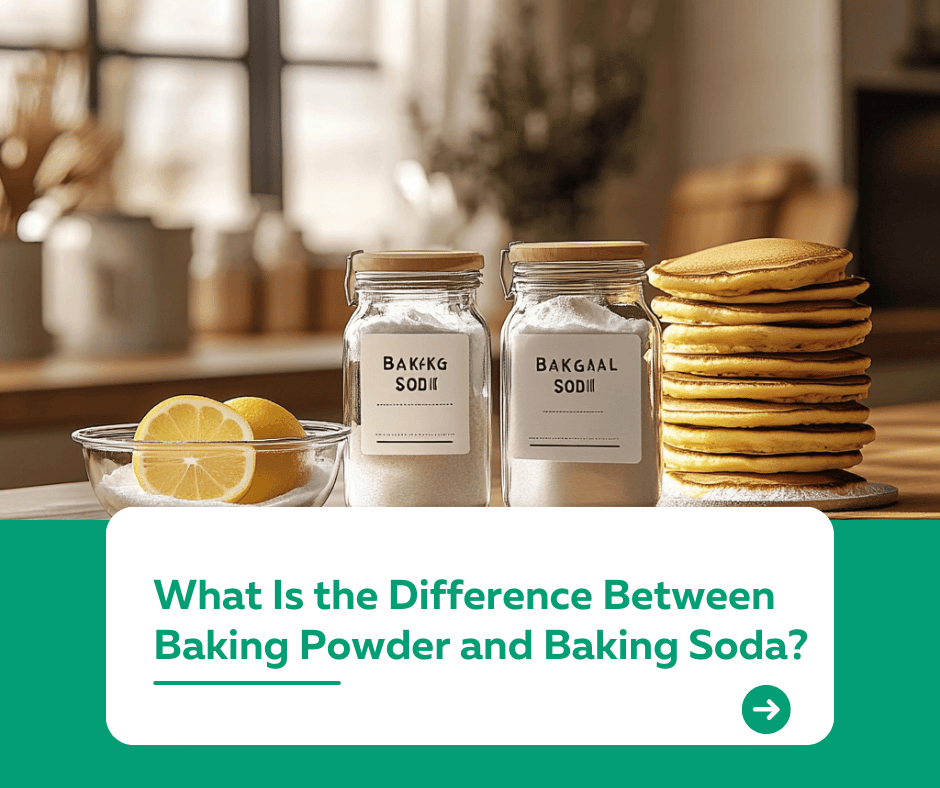
Introduction
Baking powder and baking soda are staples in every baker’s kitchen, but they’re not interchangeable. What is the difference between baking powder and baking soda, and when should you use each? This guide will help you understand how these leavening agents work and how to use them in your recipes.
1. The Basics of Baking Powder and Baking Soda
1.1 What Is Baking Soda?
- Chemical Name: Sodium bicarbonate.
- How It Works: Baking soda requires an acidic ingredient (like lemon juice, yogurt, or vinegar) and liquid to activate. This reaction produces carbon dioxide gas, which helps baked goods rise.
1.2 What Is Baking Powder?
- Composition: Baking powder contains baking soda, an acid (cream of tartar), and a moisture absorber (cornstarch).
- How It Works: Baking powder activates when mixed with liquid, and again when exposed to heat if it’s double-acting.
2. Key Differences Between Baking Powder and Baking Soda
| Feature | Baking Soda | Baking Powder |
|---|---|---|
| Ingredients | Pure sodium bicarbonate | Sodium bicarbonate + acid + starch |
| Activation | Needs acid and liquid | Activated by liquid and/or heat |
| Strength | Stronger leavening power | Weaker compared to baking soda |
| Taste | Can leave a bitter taste if overused | Neutral due to added acid |
3. When to Use Baking Soda vs. Baking Powder
Baking Soda
- Use when your recipe includes acidic ingredients (e.g., buttermilk, lemon juice, or chocolate).
- Ideal for cookies, quick breads, and cakes where rapid rising is needed.
Baking Powder
- Use when your recipe doesn’t contain acidic ingredients.
- Common in pancakes, muffins, and biscuits for a consistent rise.
4. Common Baking Mistakes and Solutions
4.1 Using the Wrong Leavening Agent
- Baking soda in place of baking powder can result in flat, bitter baked goods.
- Baking powder instead of baking soda might not provide enough rise.
4.2 Overusing Leavening Agents
- Too much baking soda or baking powder can cause baked goods to collapse or taste soapy.
4.3 Expired Products
- Always check the expiration date. Test baking soda by adding vinegar; it should bubble. Test baking powder by adding water; it should fizz.
5. Substitutions and DIY Options
Making Baking Powder
If you’re out of baking powder, mix:
- 1 teaspoon of baking soda,
- 2 teaspoons of cream of tartar,
- 1 teaspoon of cornstarch (optional for storage).
Substituting Baking Soda
If a recipe calls for baking soda but you only have baking powder, use three times the amount of baking powder.
Conclusion
Baking powder and baking soda play crucial roles in baking, but understanding their differences is key to successful recipes. Knowing when to use each ensures fluffy cakes, tender biscuits, and perfectly risen treats. For more baking tips and tricks, visit our Kuestion.com.